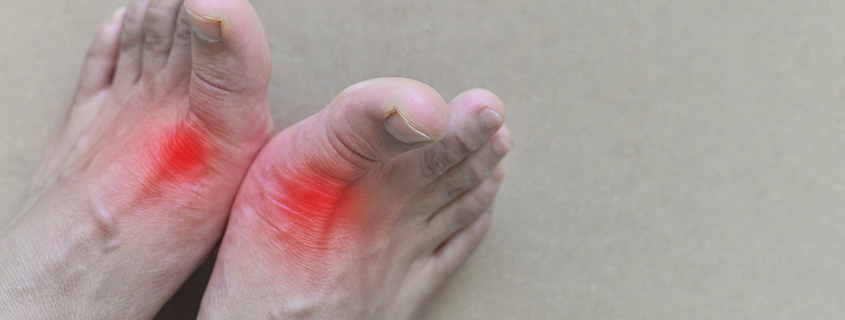Gout and Pseudogout – What Is It?
Description
Gout and pseudogout are two types of arthritis that result in sore joints. With these types of arthritis, crystals form in the joint, causing irritation that is sometimes also present in the tendons near the joint. Joints can become swollen, painful, and red (Figure 1).
These conditions can affect joints all over the body. In gout, the first joint affected is often the big toe. The elbow, wrist, and finger joints are also common sites. In pseudogout, larger joints such as the knee or wrist are more commonly involved. Painful swellings can come and go in the same joint or in different joints.
Causes
Causes of Gout
Crystals form when people make too much, or do not get rid of, uric acid. Genetics are the main factor in determining uric acid levels. However, some medicines can cause changes in uric acid levels, including medicine for high blood pressure, diuretics (water pills), some blood thinners, and a medicine called cyclosporine, which is used for patients who have had a transplanted organ. Eating meat, seafood, and alcohol can also raise uric acid levels. In addition, obesity, insulin resistance, high cholesterol, heart disease, hypothyroidism and kidney disease can be associated with with this type of arthritis. Episodes of this condition have been noted after injury or surgery, sometimes involving infection or the use of contrast for x-rays. Physical fitness seems to help with prevention.
Causes of Pseudogout
With this type of arthritis, sometimes known as calcium pyrophosphate deposition (CPPD), many people will form the crystals throughout their life, but most will not have pain, swelling or redness. It is not clear why this only becomes a problem for certain people. Symptoms are more common with age, in people who have a history of injury to a joint, and in those with a family history of these problems. Unlike gout, pseudogout is not connected with alcohol or diet and is not caused by medicine. It can occur with certain problems like pneumonia, heart attacks, and strokes, and it may occur after an unrelated surgery. It has been found in people with thyroid problems, in people who have problems with parathyroid glands, and in those with high calcium and iron.
Signs & Symptoms
Both of these conditions can appear suddenly with hot, red, or swollen joints. The joints can be so painful that they hurt to move. Sometimes joints look like they are infected, even though they are not.
Gout crystals can form white bumps called “tophi” that are often visible under the skin (Figure 2). The crystals in pseudogout are usually only visible on an x-ray (Figure 3).
The diagnosis for either disease is made based on a physical examination by your doctor, x-rays, and lab tests. You will be asked about your symptoms and how the disease has changed your activities. Because medications and other diseases can cause this condition, you will be asked to provide a medical history and a medication list.
X-rays are also helpful. Calcium in pseudogout can be seen on an x-ray. Uric acid does not show up on x-rays, but some bone changes can be visible with gout (Figure 4). If needed, fluid from the joint can be removed with a needle to confirm the diagnosis. Blood tests may be ordered to check for infection as well as uric acid levels.
Treatment
When a painful episode of this condition begins, the goal is to decrease swelling, redness, and pain. New episodes are often treated with non-steroidal anti-inflammatory (NSAID) medication or a medicine called colchicine. Steroid pills and shots may be used as well.
Episodes of can come and go. When the episodes are infrequent, an NSAID or colchicine can be used as needed. For more frequent episodes, a specific medicine can be managed by your primary care doctor or a rheumatologist.
These conditions are usually treated without surgery. There are medicines, splints, and compressions to help swelling and lessen pain. If the disease has worn out the joints or if tendons have been hurt, surgery may be needed.
If gout is not treated, the inflammation can cause damage to joints and tendons. Crystal deposits on tendons can cause the skin to wear down, which can lead to infection. In addition, tendons can tear, which can lead to loss of function.
Pseudogout crystals are less likely to be deposited under the skin, so some of the problems seen with gout are less likely. The crystals in ligaments and cartilage may lead to joint injury. Loss of motion is common.
Figure 1 – Acute gout episode with a swollen, red and painful finger
Figure 2 – Gout with tophus formation in the index and little fingers
Figure 3 – Pseudogout in the wrist often has deposits like the ones seen here
Orthopedic Sports Medicine Center of Oregon is located in Downtown Portland Oregon. Dr. Dominic Patillo, one of our Board-Certified Orthopedic Surgeons, specializes in hand surgery. His practice focuses on the treatment of both simple and complex hand and upper extremity conditions as well as general orthopaedic trauma. He is experienced with modern microsurgical techniques including nerve and vessel reconstruction.
Common problems treated include:
- carpal tunnel syndrome
- tennis elbow
- wrist pain
- sports injuries of the hand and wrist
- fractures of the hand, wrist, and forearm
- trigger finger
Other problems treated can include arthritis, nerve and tendon injuries, and congenital limb differences (birth defects).
If you have pain in your fingers, hand, wrist or arm, or if you have other upper-extremity related concerns, please consult our hand specialist Dr. Dominic Patillo for a consultation.








